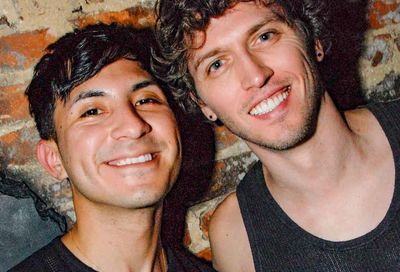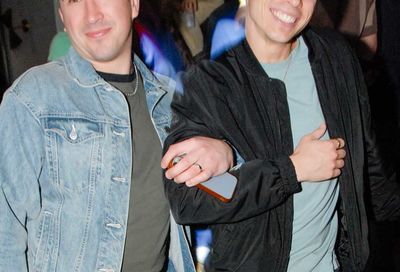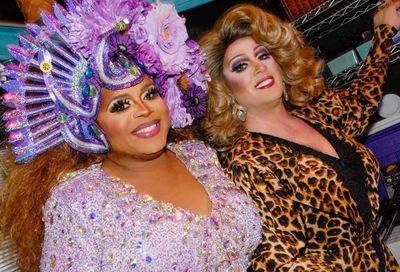Time Well Spent
Twenty-three years is a lot of time to make a difference. For Brother, Help Thyself and the organizations it supports, twenty-three years has been time well spent.
Those years have been time well spent for Larry Stansbury as well. Stansbury serves as executive director for the all-volunteer BHT, coordinating the day-to-day activities of one of the most successful community-based fundraising organizations in the nation. He’s also president of the Spartan Motorcycle Club, an organization with more than three decades of history of its own.
Stansbury is easily familiar with the history of BHT and of the Spartans, quickly recalling small details and dates that might elude others. If the present is the culmination of past moments, then Larry Stansbury is very much living in the present.
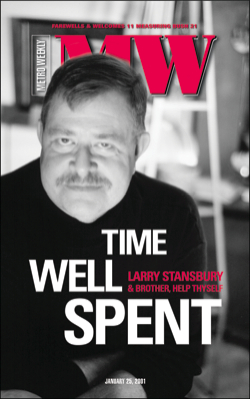
Larry Stansbury
(Photo by Todd Franson)
That seems appropriate for someone who left behind a career in administration to work as a bar bouncer; who survived and thrived after not one, but three, kidney transplants; and who wishes he could spend more time on the freedom of the open road riding his motorcycle.
This Saturday, BHT will award grants to GLBT and AIDS organizations in Washington and Baltimore. As he readied for the annual awarding of money, Stansbury talked with MW about the mission and goals of Brother, Help Thyself — and the goals he sets himself, as well.
METRO WEEKLY: How would you describe BHT’s mission?
LARRY STANSBURY: Essentially what we do is raise money within the community and give it back to gay and lesbian organizations within the community. Part of our mission obviously evolved in the 1980s when AIDS came along and we took on the burden of also raising money for AIDS service providers.
MW: What was the impetus behind the formation of the group?
STANSBURY: Maybe people get tired of hearing this, but at that point in time the Gay Men’s VD Clinic was going under. It had no resources, so we started a fundraiser to keep them afloat. That VD clinic is now Whitman-Walker Clinic.
MW: Things change over twenty-something years.
STANSBURY: I think we’ve been a part of that change. We’ve promoted these organizations all along — new organizations and organizations that have been here for a while. But it’s been a lot more so than just giving them money. It’s also offering some leadership, some guidance.
MW: How much money are you giving out this January?
STANSBURY: I’m not exactly sure yet because we’re still taking money in. We give it away right up until the last minute. We cut it off about the week before so that the treasurer doesn’t pull his hair out.
MW: What is the sort of approximate difference between what’s asked for and what’s given out?
STANSBURY: That varies a great deal because it’s dictated by variety of things. The most important is how much money we’ve raised. We break it down into different funds: the AIDS funds, the Baltimore fund, the general fund and the Medford Fund. The Medford Fund is based on an endowment — it provides material things needed by an organization. During its earliest years, there was a bass drum that Different Drummers needed. There have been computers and sewing machines, the list goes on and on. After this many years it’s getting harder and harder to remember all that we’ve given everybody.
MW: You mentioned earlier Whitman-Walker and its growth into a gigantic organization. What other success stories have you seen during your involvement with BHT?
STANSBURY: SMYAL [the Sexual Minority Youth Assistance League] is one. It may not be an eighteen million dollar organization but it’s certainly had an impact on youth. Metro Teen AIDS is one. A rather large one was Food and Friends. We gave them the first seed money, facilitated the first pots and pans they were given. What we’ve been able to do sort of runs the gamut.
MW: It’s interesting to watch how they change. I guess the question is, how does BHT get its money to give to organizations?
STANSBURY: The short of it is doing a lot of begging. We do fundraisers, everything from cake sales to auctions to raffles. If you can think of a way to make money we’ve probably already done it.
MW: Do you get corporate donations or is that too difficult?
STANSBURY: No. The hard part is we’re an all volunteer organization and you really need, at least from my perspective, a certain consistency to go after corporate donations. Corporations want to see offices and phones and people behind desks. That hasn’t been part of our style. It’s not impossible, it’s just that we’ve focused on local people to go to the fundraisers. We receive a lot of direct donations and we participate in the United Way campaign each year.
MW: After 23 years, most successful volunteer organizations probably would have gone professional. Is the spirit of volunteerism what’s important for BHT?
STANSBURY: We’ve always been all volunteers, and it’s offered opportunities for people to contribute and work with us. And it’s not all work because we have a good time at what we’re doing, too. We’ve started some newer events. For example, we’re in the fourth year of sponsoring the Gay and Lesbian Day at King’s Dominion. And it’s not a money maker, believe it or not. Most people would say, well you gotta make money at it. We do it purely as a visibility thing for gays and lesbians to get out there and have a good time.
MW: When you go down to King’s Dominion, are you a roller coaster person?
STANSBURY: I think I’ve long since passed the days of being a roller coaster person. I know lots of people that are. I tend to be one of the workers — I usually end up working the whole time.
MW: Were you surprised that King’s Dominion was welcoming with the event?
STANSBURY: I think they came into it as neutral but guarded, but when they realized that it was one of the best behaved crowds that they’ve ever had in the park, they very rapidly said, ”When are you coming back?”
MW: How many organizations make up BHT?
STANSBURY: Thirteen.
MW: Are they primarily from the leather community or the motorcycle clubs?
STANSBURY: That’s where we started. We’ve since added other groups. The bear clubs, if you’re familiar with them. Even earlier we had added the rodeo, ASGRA, as well as the Academy Awards from the drag community.
MW: Do you think BHT is perceived as a leather organization?
STANSBURY: I’m sure it is. I don’t have any doubt in my mind. But the people who are receiving the money from us understand quickly that it doesn’t matter. We’ve helped a number of women’s organizations get started over the years. We’re strong supporters of the Mautner Project [for Lesbians with Cancer]. There don’t seem to be a lot of structured women’s organizations out there — as a male that’s just the perception I have. I’d love to see more of them.
MW: When BHT started and through the earlier years it was primarily a leather organization, though. The leather community was under a lot of fire during the early part of the AIDS epidemic, from some people who perceived the leather community as an ”instigator” of the disease. Did BHT suffer from those types of perception problems?
STANSBURY: All along, there has been a misconception what the leather community has been about. We’re very much like everybody else, we just have a particular like of leather. Some of us because we ride motorcycles, and for some people it’s more of a dress statement. But a lot of people just don’t understand that.
The Spartan Motorcycle Club is thirty-three years old. The Academy Awards is thirty-eight years old. Those are two of the longest surviving organizations in this city — a leather group and a drag group. Even though some people see the leather community as one of those ”branch” communities, the strength of the gay community has started and continues with the leather community. You’ll find some of the most dedicated people you’ll ever meet.
MW: Would you say the perception of the leather community has changed at all over the past ten years or so?
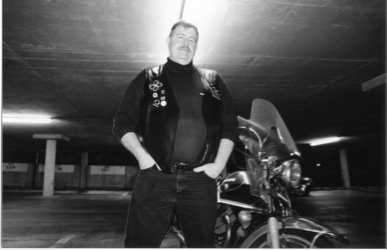
Larry Stansbury
(Photo by Todd Franson)
STANSBURY: I think visibility is helping a lot. We don’t make apologies because we wear leather or Levis. A lot of people wear Levis now and guess where it started? And a lot of that started with the D.C. Eagle. So many people have misconceptions about the Eagle. ”Oh, that’s a leather bar, I’m afraid to go in there.” It has its own mystique, a well deserved one. It caters to the leather/Levi community, but everybody’s been welcome there.
MW: One of the reasons I asked about the change in perception is because Mid-Atlantic Leather weekend seems to have grown a lot over the past few years. It seems to draw even more of a ”non-leather” crowd, which is interesting because different scenes tend to keep to themselves.
STANSBURY: I think it offers opportunities for people to explore other venues. It would be wrong to assume that every person in leather is into heavy S&M. Some are, but not everybody is. There’s probably a parallel between that and other crowds around town. There’s a whole group of young people who are into the circuit parties. You see a variety of cliques or people who have just gravitated to where they’re comfortable. There’s a longstanding support in the leather community for the Eagle, and I’ve been part of that support. I worked for the Eagle when I came here in 1978.
MW: What brought you to D.C.?
STANSBURY: [I was in hospital administration] in Richmond, Virginia. I wanted to do something different, so I started working in the bars in Richmond. I worked as a bouncer, as a bartender, as a DJ, a whole bunch of different ways. I tend to be a night person so it was an easy transition. For some reason, hospitals think that every meeting has to start at 7 a.m. — they don’t know that you’re supposed to go home after eight hours. There’s a toll that you pay with that, and you get to a point where you say, I need a change. That was part of my change. I was spending weekends in Washington, so I was very familiar with the bars here long before I made the commitment to move here.
MW: You were raised in Richmond — were you there until 1978?
STANSBURY: Well, I spent time in the Navy. I’m also a veteran.
MW: Did you serve in any conflicts?
STANSBURY: During Vietnam, but it’s funny — I was very good at what I did in operating rooms and emergency rooms, so every time I got orders to go to Vietnam, the commander of the base would say, ”We need you here [in Norfolk].” The only time I ever set foot on a ship was for a tour.
MW: Were you drafted or did you volunteer?
STANSBURY: A combination. I knew the draft was on my butt, so I volunteered as a ”non-combatant.”
MW: Did you know that you were gay at the time?
STANSBURY: Oh, yes. I’d known that since I was about thirteen. I was an early bloomer.
MW: Was the Navy a hard place for that?
STANSBURY: I essentially lived off base, so you might say I had a fair amount of liberty without people watching over my shoulder. I was always on time, always did my job, and so there was never any issue. It actually made me a lot more relaxed with being myself. I realized that I could be who I was and still do a job, and that’s pretty much how I separated my life. Since I’m totally retired now, I can just be me all the time.
MW: Back to your moving to D.C. — what led you to move from Richmond?
STANSBURY: You might say I sort of outgrew the bars in Richmond. I was looking for something a little more exciting, and I was offered a job at the Eagle. My first job was as bouncer at the door. Back then you actually bounced people. These days it’s probably more subtle — there’s more pressure to keep people manageable so you don’t have as many crazies.
[I worked a number of jobs] at the Eagle, and it was a rewarding experience. But there came a point in time when I left and went back to hospital administration. Not one of my stellar periods, but I’ll just leave that one at that. But that was around 1984, when I had my first [kidney] transplant.
MW: Your first transplant?
STANSBURY: What they do is remove both kidneys and put in the new one. I got the first transplant, and without getting too gruesome about it, within thirty days I had [to have a] second transplant. The second one lasted till pretty close to 1992. The life expectancy of a kidney [from a cadaver] wasn’t as long as it is now, the drugs have been refined. So in 1994, I got my third transplant.
MW: Is the waiting list for a kidney as long as for a liver or a heart?
STANSBURY: Well, from cadaver donors there are two kidneys, so two people have a chance instead of just one. You can function very well with just one.
MW: Were you on dialysis during those periods?
STANSBURY: Yeah, and I was one of those people who didn’t tolerate it very well. When I had my last transplant I was down to 135 pounds. Regardless of advances, some people just do not acclimate to dialysis. I’m one of those, so it’s important that I keep my transplant kidney.
MW: Is receiving an organ from a person who died a difficult thing to get your mind around?
STANSBURY: I have to speak to my own experience for that. I’m extremely grateful, but I also keep in the back of my mind that it’s not my time to go yet, and so there must be a reason I’m still here. There’s a burden of working to accomplish what you feel you needto accomplish.
MW: Do you feel you’ve made good progress toward that?
STANSBURY: Well, do we ever really know?
MW: But do you have your own goals? Obviously, you feel you have some sort of responsibility to accomplish things.
STANSBURY: It’s a double-edged sword. Part of the need to do what I’m doing is based on the concept that if I stay busy I don’t have time to focus on those other issues. Don’t get me wrong — I monitor my health closely because that’s necessary. But I am focused on the things that I am doing with BHT especially, and as president of the Spartans. I’m also very involved in issues in Alexandria, where I live.
MW: How long have you been the executive director of BHT?
STANSBURY: Title-wise, the last four years. That’s when we finally said, we need somebody to be responsible every day. Everything from correspondence to answering the phone to handling the advertising. What’s interesting to me is that with the increase in our advertising, we’re getting many more calls from people looking for help. I can direct them to other organizations best prepared to help them.
MW: What would you say is the most frustrating thing about your job?
STANSBURY: You want to be able to help people and you know that your resources only stretch so far. It’s the same feeling that most of the directors go through when there are thirty seven groups that ask for money and you can only stretch it so far and still have any meaningful impact on their operations. So some groups may only get two hundred dollars, but some may get several thousand dollars.
MW: And what’s the most satisfying thing?
STANSBURY: To see things we’ve had our hands on at some point in time grow and reach out to so many more people. Years ago there was a group called DC Sports. We gave them their seed money, and they grew and grew. There came a time when DC Sports faded away, and now we have all these different sports activities around town. DC Sports came into existence, served its purpose, and then when they recognized that they weren’t really needed anymore they faded out. But now we have all these other organizations out there.
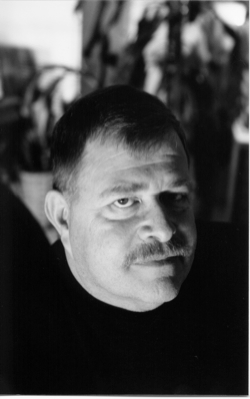
Larry Stansbury
(Photo by Todd Franson)
MW: One last question: How often do you ride your motorcycle?
STANSBURY: I haven’t in the last few weeks. With trying to get everything out for the grant distribution on the 27th, I’ve just been going. But I try to ride year round.
MW: What kind of bike do you have?
STANSBURY: I have a Moto Guzzi, an Italian bike. It’s a fairly large bike; it’s comfortable for riding long distances. I’ve toured from Canada to the Keys, back and forth across the country several times.
MW: What’s the best thing about being on a motorcycle?
STANSBURY: Freedom.
MW: Freedom because of the openness?
STANSBURY: The openness, the freedom, you’re sort of out there and you can just be with yourself without any other interferences. Even riding in a club, each of us rides individually, although we also ride as a group. There’s a certain camaraderie, a fraternal atmosphere within our club. You know you’re a part of something you enjoy doing. So this thing about bikers, it’s true: we like the freedom. I wish sometimes I could get out more. I’ve gone through brief periods where I wasn’t allowed to ride because of surgeries or transplants or stuff like that. But I’m only going through this life once, and I want to make the best of it.
Support Metro Weekly’s Journalism
These are challenging times for news organizations. And yet it’s crucial we stay active and provide vital resources and information to both our local readers and the world. So won’t you please take a moment and consider supporting Metro Weekly with a membership? For as little as $5 a month, you can help ensure Metro Weekly magazine and MetroWeekly.com remain free, viable resources as we provide the best, most diverse, culturally-resonant LGBTQ coverage in both the D.C. region and around the world. Memberships come with exclusive perks and discounts, your own personal digital delivery of each week’s magazine (and an archive), access to our Member's Lounge when it launches this fall, and exclusive members-only items like Metro Weekly Membership Mugs and Tote Bags! Check out all our membership levels here and please join us today!


















